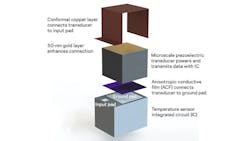Researchers Develop a Wireless Implantable Sensor Small Enough to be Injected
Researchers at Columbia University have built a single-chip device that takes up less than 0.000006 in.3 (0.1 mm3), making it the smallest such system ever made. The device was made to be injected into humans and monitor various biological parameters. To keep it small, the team designed it to communicate and be powered wirelessly by ultrasound. The goal is to replace larger implantable sensors that require several chips, packaging, wires, external transducers, and batteries. The team also wanted an implant that could be injected, and it is small enough to do that (it takes a microscope to see the implantable sensor).
“We wanted to see how far we could push the limits on how small a functioning chip we could make,” says Ken Shepard, the team leader and a professor of electrical and biomedical engineering. “This is a new idea of ‘chip as system.’ This is a chip that alone, with nothing else, is a complete functioning electronic system. It should be revolutionary for developing wireless, miniaturized implantable medical devices that can sense different things, be used in clinical applications and eventually be approved for human use.”
The chip was fabricated at the Taiwan Semiconductor Manufacturing Co., and then modified at the Columbia Nano Initiative cleanroom and City University of New York Advanced Science Research Center. The modifications included adding piezoelectric materials onto the standard complementary metal-oxide-semiconductor to convert acoustic energy to electrical energy.
The team chose ultrasound as the best way to send energy and communications to the chip because the wavelengths needed for RF communication links are too large to work with devices as small as the new single-chip device. Ultrasound wavelengths are much smaller at a given frequency because the speed of sound is much less than the speed of light. The researchers built an ultrasound “antenna” for communications and power and mounted it directly on top of the chip.
The team’s goal is to develop chips that can be injected into the body with a hypodermic needle and then communicate back out of the body using ultrasound, providing information about something being measured locally. Current versions of the device measure body temperature, but there are many more possibilities, and the team is working on them.

